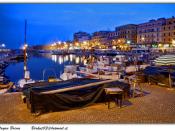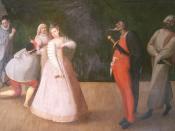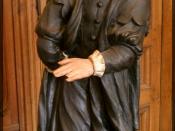Commedia dell'arte is a truly popular form of theatre - of the people, by the people, for the people.
Commedia dell'arte is definitely an art form centred on people and their world. Commedia del'Arte emerged in Tuscany around 1550, Although its origins are hazy due to the illiteracy of its first performers and audience, it is believed to have stemmed from the carnivals in Italy . Here it rose from the people from folk theatre, which used masks and music, and from the charlatans using pretence as a means of earning money.
The form combined mime, improvised and scripted dialogue (often coarse), with tumbling and acrobatics. Commedia del'Arte performances and techniques spread throughout Europe during the 16th and 17th centuries, with offshoots in France, Spain and England. The scenarios involved in Commedia arose from the thematic concerns the form had. It was mainly concerned with examining the human condition via satire.
Therefore, the canovaccios were filled with driving themes such as food, drink, sex, love, money and vengeance. The artists created the scenarios to fit into the peoples living conditions as a safety valve. They could laugh at their situation on stage, making their conditions a little more bearable. In this way, Commedia was designed by troupes, simply the Italian public, for their audience and the people. A del'Arte company consisted of 10 or 12 strolling players. Each was assigned a stock part and had his standard costume and established peculiarities. Stock characters came from the people in that they were often satirizations of them.
Ill Dottore, an expert on everything who could talk unendingly, was a satirization of the bolognese academics. Ill Capitano was a satirization of invaders of Italy, particularly the Spanish army. Pulchinella is believed to have been derived directly from an interjecting peasant whom the troupes...


